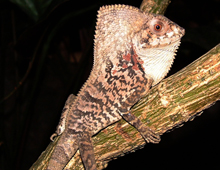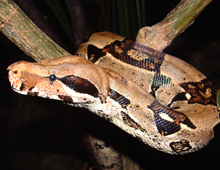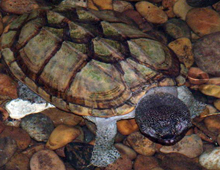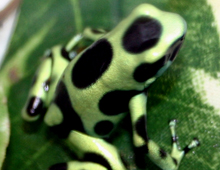Reptiles and Amphibians

Helmeted basilisk, Corytophanes cristatus
An enormously developed extension of its skull lends this lizard a resemblance to the “Alien” of horror movies. In contrast to other basilisks (which can run so quickly they can stay above the water surface) this tree-dwelling species is a “sit and wait predator”, staying very still, until large beetles, grasshoppers, and other insects, deceived by its unlizardlike appearance, come close enough to be grabbed in its jaws. Found in Southern Mexico and the rest of Central America, it is not often seen in zoos. It has reproduced at the DWA.
LEARN MORE
Red-tailed boa constrictor, Boa constrictor ortonii
Found from Mexico to Paraguay, this is one of the most well-known snakes, and has been popular in zoos for well over a century. It is also common in private collections. While it has a reputation as a giant, it actually rarely reaches 14 feet, and has never been documented to reach 20 feet. In contrast to the much larger Anaconda, it is not dependent on water in its environment, though it swims quite well. A nocturnal animal, it is often motionless during zoo visiting hours.
LEARN MORE
Mexican giant musk turtle, Staurotypus triporcatus
Known as the Gua in Mexico, this huge-headed turtle is also found in Belize, Honduras, and Guatemala. A giant among the musk and mud turtle family, it can attain a shell length of 14 inches. Despite its superficial resemblance to snapping turtles, it is not related. Prized as food because of its size, it is considered near-threatened. It is not common in collections, but has bred repeatedly at the DWA.
LEARN MORE
Mexican beaded lizard, Heloderma horridum
This larger, more arboreal relative of the Gila monster is easily distinguished from it by being black and cream-colored, rather than black and pinkish-orange. Like the Gila monster, it is venomous, possessing glands in its lower jaw. It is not found in the US, but occurs in Mexico and Guatemala. It appears to feed almost entirely on eggs of birds and other reptiles. Prized as a zoo exhibit, it has been bred in several collections, including the DWA.
LEARN MORE
Middle American rattlesnake, Crotalus simus
Found from northern Mexico to Central America, it was only separated by herpetologists from the South American Tropical Rattlesnake (Crotalus durissus) in 2004. Unlike its South American relative, but in common with most other rattlesnake species, its adult venom is primarily haemotoxin, rather than neurotoxin. It stands out among other Mexican Rattlesnakes for the twin stripes running from the back of its head down a portion of its body, and its unusually rough-looking scales. Rattlesnakes were revered by the Mayans and Aztecs.
LEARN MORE
Crevice spiny lizard, Sceloporus poinsettia
There are more than ninety species in the genus Sceloporus, many of them familiar as “Blue-bellies”, “Swifts”, and “Fence Lizards”. In the same family as “Horned Toads”, they are found across through much of the US, Mexico, and Central America. This species is found throughout in the Chihuahuan Desert, on both sides of the border in Texas, New Mexico, Chihuahua and Coahuila. Its name honors Joel Poinsett, amateur scientist and first US minister to Mexico (1825-1830) after whom the Poinsettia is also named.
LEARN MORE
Red-eyed tree frog, Agalychnis callidryas
For years this amphibian was known either as a spectacular subject of photos, or as a lump-like creature, fast asleep while stuck to a leaf or the wall or glass of its exhibit. Experiments with lighting at the DWA have resulted in increased activity, so that the startling red eyes and beautifully patterned legs and flanks are more likely to be appreciated. Found from Mexico to Northern Colombia, this is another frog that lays its eggs on leaves above water, into which the tadpoles fall.
LEARN MORE
Green and black poison dart frog, Dendrobates auratus
From Panama and Colombia, this is one of the most familiar of the poison dart frogs in collections, and is considered comparatively easy to keep and breed. It was introduced to the island of Oahu more than 50 years ago, and can be seen in front yards in suburbs of Honolulu. It continues to do well in its native habitat as well.
LEARN MORE

